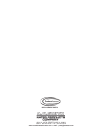
8
HIGH ALTITUDE INSTALLATION
WARNING
INSTALLATIONS ABOVE 2000 FT. REQUIRE REPLACEMENT
OF THE BURNER ORIFICE IN ACCORDANCE WITH THE FUEL
GAS CODE (ANSI Z223.1/NFPA 54). FAILURE TO REPLACE
THE ORIFICE COULD RESULT IN IMPROPER AND
INEFFICIENT OPERATION OF THE APPLIANCE, PRODUCING
CARBON MONOXIDE GAS IN EXCESS OF SAFE LIMITS,
WHICH COULD RESULT IN SERIOUS INJURY OR DEATH.
CONTACT YOUR GAS SUPPLIER FOR ANY SPECIFIC
CHANGES WHICH MAY BE REQUIRED IN YOUR AREA.
A.O. SMITH DOES BUILD SOME MODELS SPECIFICALLY FOR
HIGH ALTITUDE SERVICE.
PLEASE CHECK THE RATING PLATE BEFORE MAKING
CHANGES.
DRAFT HOOD OPERATION
Check draft hood operation by performing a worst case
depressurization of the building. With all doors and windows
closed, and with all air handling equipment and exhaust fans
operating, such as furnaces, clothes dryers, range hoods and
bathroom fans, a match flame should still be drawn into the draft
hood of the water heater with its burner firing. If the flame is not
drawn toward the draft hood, shut off water heater and make
necessary air supply changes to correct.
TEMPERATURE REGULATION
DANGER
THIS WATER HEATER IS EQUIPPED WITH AN ADJUSTABLE
THERMOSTAT TO CONTROL WATER TEMPERATURE. HOT
WATER TEMPERATURES REQUIRED FOR AUTOMATIC
DISHWASHER AND LAUNDRY USE CAN CAUSE PAINFUL
SCALDING WITH POSSIBLE SERIOUS AND PERMANENT
INJURY. THE TEMPERATURE AT WHICH INJURY OCCURS
VARIES WITH THE PERSON'S AGE AND THE TIME OF
EXPOSURE. THE SLOWER RESPONSE OF CHILDREN,
AGED OR DISABLED PERSONS INCREASES THE HAZARDS
TO THEM. NEVER ALLOW SMALL CHILDREN TO USE A HOT
WATER TAP, OR TO DRAW THEIR OWN BATH WATER. NEVER
LEAVE CHILD OR DISABLED PERSON UNATTENDED IN A
BATHTUB OR SHOWER.
THE WATER HEATER SHOULD BE LOCATED IN AN AREA
WHERE THE GENERAL PUBLIC DOES NOT HAVE ACCESS.
IF A SUITABLE AREA IS NOT AVAILABLE, A COVER SHOULD
BE INSTALLED OVER THE THERMOSTAT TO PREVENT
TAMPERING. Suitable covers are available through A.O. Smith
Water Products Company, 5621 W. 115th Street, Alsip, IL 60803.
It is recommended that lower water temperatures be used to
avoid the risk of scalding. It is further recommended, in all
cases, that the water temperature dial, Figure 1, be set for the
lowest temperature which satisfies your hot water needs. This
also will provide the most energy efficient operation of the water
heater. The water temperature adjusting dial was factory set at
the lowest temperature; all the way clockwise to the mechanical
stop. Turning the dial counterclockwise
increases
temperature, and clockwise reduces temperature.
SETTING THE WATER HEATER TEMPERATURE AT 120°F
(APPROX.
MARK ON FACE OF THERMOSTAT) WILL
REDUCE THE RISK OF SCALDS. Some states require settings
at specific lower temperatures.
Figure 4 shows the approximate water temperatures produced
at various thermostat dial settings. Short repeated heating
cycles caused by small hot water uses can cause temperatures
at the point of use to exceed the thermostat setting by up to
30°F. If you experience this type of use you should consider
using lower temperature settings to reduce scald hazards.
Valves for reducing the
point-of-use temperatures by mixing cold
and hot water are available (see fig. 2). Also available are
inexpensive devices that attach to faucets to limit hot water
temperatures. Contact a licensed plumber or the local plumbing
authority.
SHOULD OVERHEATING OCCUR OR THE GAS SUPPLY FAIL
TO SHUT OFF, TURN OFF THE MAIN MANUAL GAS SHUTOFF
VALVE TO THE APPLIANCE. SEE FIGURE 1.
VERY HOT = approx. 160°F About 1/2 second
C = approx. 150°F about 1-1/2 seconds
B = approx. 140°F Less than 5 seconds
A = approx. 130°F About 30 seconds
= approx. 120°F More than 5 minutes
LOW = approx. 80°F - - - - - - - - - - - - - - - -
FIGURE 4
Time to Produce 2nd & 3rd
Degree Burns on Adult
Temperature Settings














